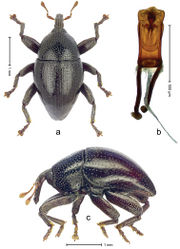Trigonopterus puncticollis
| Notice: | This page is derived from the original publication listed below, whose author(s) should always be credited. Further contributors may edit and improve the content of this page and, consequently, need to be credited as well (see page history). Any assessment of factual correctness requires a careful review of the original article as well as of subsequent contributions.
If you are uncertain whether your planned contribution is correct or not, we suggest that you use the associated discussion page instead of editing the page directly. This page should be cited as follows (rationale):
Citation formats to copy and paste
BibTeX: @article{Van2016ZooKeys, RIS/ Endnote: TY - JOUR Wikipedia/ Citizendium: <ref name="Van2016ZooKeys">{{Citation See also the citation download page at the journal. |
Ordo: Coleoptera
Familia: Curculionidae
Genus: Trigonopterus
Name
Trigonopterus puncticollis Van Dam & Riedel sp. n. – Wikispecies link – ZooBank link – Pensoft Profile
Diagnostic description
Holotype, male (Fig. 3a–c). Length 3.06 mm. Color black, antenna and tarsi ferruginous. Body subovate; with weak constriction between pronotum and elytra; in profile evenly convex. Rostrum in basal half with median and pair of submedian carinae, intervening furrows with rows of yellowish-transparent scales; apical half of rostrum coarsely punctate-rugose, with sparse suberect setae. Forehead coarsely punctate-rugose, punctures with subrecumbent scales pointing backwards. Pronotum coarsely punctate; distance between punctures subequal to their diameter; each puncture containing one inconspicuous seta. Elytra finely punctate, along basal margin with transverse row of deeper and denser punctures; striae impressed as fine lines; marked by rows of small punctures; intervals flat, subglabrous, with few minute punctures; lateral stria behind humerus with dense row of deep punctures. Femora edentate; subapically coarsely punctate, with recumbent scales. Anteroventral ridge of profemur in apical third shortened, forming blunt angulation. Metafemur dorsoposteriorly denticulate; subapically without stridulatory patch. Protibia widening towards apex. Mesotibia in apical half with anterior face covered by fringe of long subrecumbent setae. Meso- and metatibia subbasally with dorsal angulation; metatibia with supra-uncal denticle. Abdominal ventrites 1–2 concave with coarse punctures bearing silvery plumose scales; ventrite 5 flat, densely punctate and covered with silvery scales. Penis (Fig. 3b) widening apicad, in apical third with constriction and oblique lateral furrow; apex subangulate, subglabrous; transfer apparatus symmetrical, contained in apical half of body; ductus ejaculatorius without bulbus. Intraspecific variation. Length 2.58–2.85 mm. Female mesotibia apically with large uncus and much smaller premucro. Female abdominal ventrites 1 and 2 medially flat.
Material examined
Holotype (ANIC): ARC4220 (GenBank # KU888900), PAPUA NEW GUINEA, West New Britain Prov.: E of Silali Village, Nakanai Range, S 05°30.651', E 151°02.895', 700 m, from foliage, 21-XI-2014. Paratypes (SMNK, ZSM, UPNG): 9 exx, ARC4218 (EMBL # KU888898), ARC4219 (GenBank # KU888899), ARC4221 (EMBL # XXX), same data as holotype.
Etymology
This epithet is a Latin adjective based on a combination of the Latin nouns punctum (small hole, dot) and collum (neck) and refers to the markedly punctate pronotum.
Notes
This species may belong to the Trigonopterus oblongus-group of Riedel et al. (2013b)[1] in a wide sense.
Original Description
- Van Dam, M; Laufa, R; Riedel, A; 2016: Four new species of Trigonopterus Fauvel from the island of New Britain (Coleoptera, Curculionidae) ZooKeys, (582): 129-141. doi
Images
|
Other References
- ↑ Riedel A, Sagata K, Surbakti S, Tänzler R, Balke M (2013b) One hundred and one new species of Trigonopterus weevils from New Guinea. ZooKeys 280: 1–150. doi: 10.3897/zookeys.280.3906
